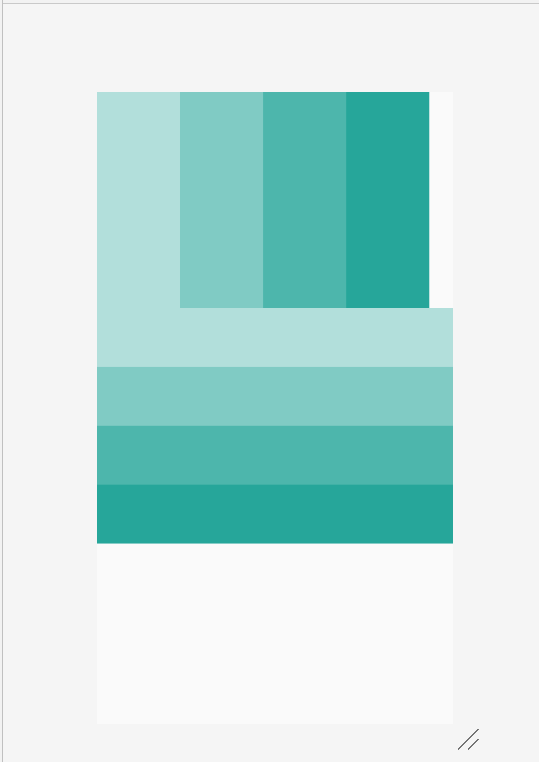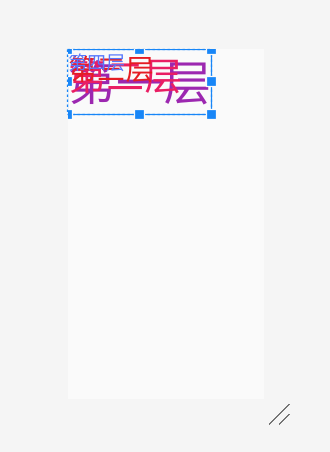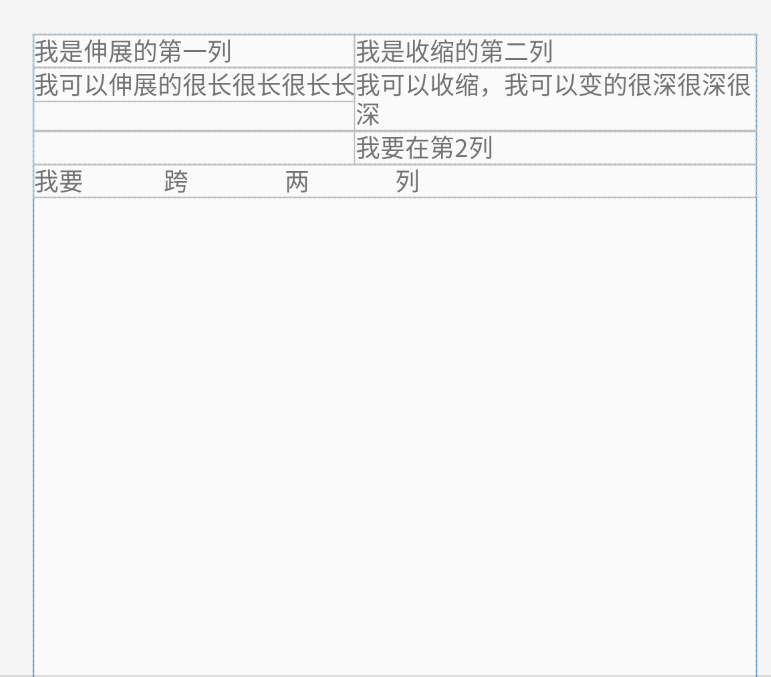1、LinearLayout(线性布局)
该布局将其中的View子控件按照水平或者垂直方向排列。但是需要注意不管是水平还是竖直,对应的每一行或列都只能放一个控件。
线性布局两种排法:
从左到右:android:orientation="horizontal"
从上到下:android:orientation="vertical"
效果如下:

<?xml version="1.0" encoding="utf-8"?> <LinearLayout xmlns:android="http://schemas.android.com/apk/res/android" android:layout_width="match_parent" android:layout_height="match_parent" android:orientation="vertical"> <LinearLayout android:layout_width="match_parent" android:layout_height="250dp" android:orientation="horizontal"> <TextView android:layout_width="96dp" android:layout_height="match_parent" android:background="#b2dfdb" /> <TextView android:layout_width="96dp" android:layout_height="match_parent" android:background="#80cbc4" /> <TextView android:layout_width="96dp" android:layout_height="match_parent" android:background="#4db6ac" /> <TextView android:layout_width="96dp" android:layout_height="match_parent" android:background="#26a69a" /> </LinearLayout> <LinearLayout android:layout_width="match_parent" android:layout_height="match_parent" android:orientation="vertical"> <TextView android:layout_width="match_parent" android:layout_height="68dp" android:background="#b2dfdb" /> <TextView android:layout_width="match_parent" android:layout_height="68dp" android:background="#80cbc4" /> <TextView android:layout_width="match_parent" android:layout_height="68dp" android:background="#4db6ac" /> <TextView android:layout_width="match_parent" android:layout_height="68dp" android:background="#26a69a" /> </LinearLayout> </LinearLayout>
一个竖向的大LinearLayout嵌套着两个小LinearLayout,第一个小LinearLayout为横向,第二个小LinearLayout为竖向。
2、RelativeLayout布局
参考其他控件进行布局,默认为父控件。
有三种类型的属性:
属性值是true或false
android:layout_centerHrizontal 水平居中
android:layout_centerVertical 垂直居中
android:layout_centerInparent 相对于父元素完全居中。
android:layout_alignParentBottom 位于父元素的下边缘
android:layout_alignParentTop 位于父元素的上边缘
android:layout_alignParentLeft 位于父元素的左边缘
android:layout_alignParentRight 位于父元素的右边缘
属性值是“@id/*”
android:layout_below 在某元素的下方
android:layout_above 在某元素的上方
andorid:layout_toRightOf 在某元素的右方
android:layout_toLeftOf 在某元素的左方
android:layout_alignBottom 和某元素下方对齐
android:layout_alignTop 和某元素上方对齐
android:layout_alignRight 和某元素右方对齐
android:layout_alignLeft 和某元素左方对齐
属性值是数值
android:layout_marginLeft 离某元素左边缘的距离
android:layout_marginRight 离某元素右边缘的距离
android:layout_marginTop 离某元素上边缘的距离
android:layout_marginBottom 离某元素下边缘的距离
注意:
如果没有定义左右,那么默认在左边,如果没有定义上下,默认在上边。
相同位置,新定义的元素会覆盖旧的元素。
只定义在父元素的下部,左右没有定义,默认在左边。
android:layout_below,在某元素的下部并不意味着就一定是紧随某元素,只是在下部的默认位置。
3、MyLayout布局(自定义ViewGroup)
自定义布局主要是重写两个方法:
onMeasure()写自定义容器的大小。
onLayout()写子元素的布局。
3.1、onMeasure()
@Override protected void onMeasure(int widthMeasureSpec, int heightMeasureSpec) { /** * 获得此ViewGroup上级容器为其推荐的宽和高,以及计算模式 */ int widthMode = MeasureSpec.getMode(widthMeasureSpec); int heightMode = MeasureSpec.getMode(heightMeasureSpec); int sizeWidth = MeasureSpec.getSize(widthMeasureSpec); int sizeHeight = MeasureSpec.getSize(heightMeasureSpec); // 计算出所有的childView的宽和高 measureChildren(widthMeasureSpec, heightMeasureSpec); /** * width和height是当wrap_content时使用的属性。 */ int width = 0; int height = 0; int cCount = getChildCount(); int cWidth = 0; int cHeight = 0; /** * 在这里计算当wrap_content时,布局的大小。 */ for (int i = 0; i < cCount; i++) { View childView = getChildAt(i); cWidth = childView.getMeasuredWidth(); cHeight = childView.getMeasuredHeight(); width += cWidth; height += cHeight; } /** * 如果是wrap_content设置为我们计算的值 * 否则:直接设置为父容器计算的值 */ setMeasuredDimension((widthMode == MeasureSpec.EXACTLY) ? sizeWidth : width, (heightMode == MeasureSpec.EXACTLY) ? sizeHeight : height); }
布局计算模式,即最后的EXACTLY。共有三种计算模式:
MeasureSpec.EXACTLY:精确尺寸,相当于具体数值和match_parent.
MeasureSpec.AT_MOST:最大尺寸,相当于warp_content.
MeasureSpec.UNSPECIFIED:未指定尺寸,这种情况不多,一般用于AdapterView.
3.2、onLayout()
@Override protected void onLayout(boolean changed, int l, int t, int r, int b) { int cCount = getChildCount(); /** * 遍历所有childView根据其宽和高,以及margin进行布局 */ for (int i = 0; i < cCount; i++) { View childView = getChildAt(i); r = l + childView.getMeasuredWidth(); b = t + childView.getMeasuredHeight(); childView.layout(l, t, r, b); l += childView.getMeasuredWidth(); t += childView.getMeasuredHeight(); } }
这个方法的作用是设置摆放子元素的位置。其中onLayout()传入的l、t、分别是对应子元素左上角的left,top坐标。r、b分别是对应子元素右下角的right,bottom坐标。
可以使用childview.getMeasureWidth()和childView.getMeasureHeight()得到子元素的宽和高。
xml代码如下:
<?xml version="1.0" encoding="utf-8"?> <com.example.layoutdemo.MyLayout.MyLayout xmlns:android="http://schemas.android.com/apk/res/android" android:layout_width="wrap_content" android:layout_height="wrap_content" > <TextView android:layout_width="50dp" android:layout_height="50dp" android:background="#b2dfdb" /> <TextView android:layout_width="50dp" android:layout_height="50dp" android:background="#80cbc4" /> <TextView android:layout_width="50dp" android:layout_height="50dp" android:background="#4db6ac" /> <TextView android:layout_width="50dp" android:layout_height="50dp" android:background="#26a69a" /> </com.example.layoutdemo.MyLayout.MyLayout>
4、FrameLayout布局
帧布局,这个布局的特点是从左上角开始,后面的会覆盖前面的控件。
<?xml version="1.0" encoding="utf-8"?> <FrameLayout xmlns:android="http://schemas.android.com/apk/res/android" android:layout_width="match_parent" android:layout_height="match_parent" android:orientation="vertical"> <TextView android:layout_width="wrap_content" android:layout_height="wrap_content" android:textSize="100dp" android:textColor="#9c27b0" android:text="第一层"/> <TextView android:layout_width="wrap_content" android:layout_height="wrap_content" android:textSize="80dp" android:textColor="#e91e63" android:text="第二层"/> <TextView android:layout_width="wrap_content" android:layout_height="wrap_content" android:textSize="60dp" android:textColor="#e51c23" android:text="第三层"/> <TextView android:layout_width="wrap_content" android:layout_height="wrap_content" android:textSize="40dp" android:textColor="#5677fc" android:text="第四层"/> </FrameLayout>
效果图如下:

5、TableLayout布局
表格布局,应遵循以下布局结构。
<TableLayout> <TableRow> <!-在这里填充第一行的元素-> </TableRow> <TableRow> <!-在这里填充第二行的元素-> </TableRow> </TableLayout>
几个重要属性:
写在TableLayout中的属性
android:stretchColumns 设置第几列为伸展(0表示第一列)
android:shrinkColumns 设置第几列为收缩
android:collapseColumns 设置第几列为隐藏
写在TableRow里的控件里的属性
android:layout_column 设置控件在第几列
android:layout_span 设置控件能跨多少列
代码如下:
<?xml version="1.0" encoding="utf-8"?> <TableLayout xmlns:android="http://schemas.android.com/apk/res/android" android:layout_width="match_parent" android:layout_height="match_parent" android:collapseColumns="2" android:shrinkColumns="1" android:stretchColumns="0"> <TableRow > <TextView android:text="我是伸展的第一列" /> <TextView android:text="我是收缩的第二列" /> <TextView android:text="我被隐藏了" /> </TableRow> <TableRow> <TextView android:text="我可以伸展的很长很长很长长" /> <TextView android:text="我可以收缩,我可以变的很深很深很深" /> <TextView android:text="我被隐藏了T_T" /> </TableRow> <TableRow> <TextView android:layout_column="1" android:text="我要在第2列" /> </TableRow> <TableRow> <TextView android:layout_width="wrap_content" android:layout_height="wrap_content" android:layout_column="0" android:layout_span="2" android:text="我要 跨 两 列" /> </TableRow> </TableLayout>
效果图如下:

参考文章:https://blog.csdn.net/u013254061/article/details/52512146